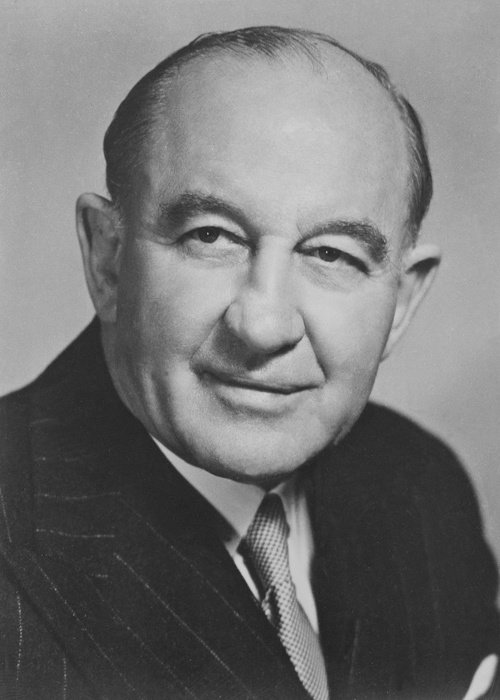On this day, 19 March 1951, the Governor General William McKell dissolves the House of Representatives and the whole Senate in accordance with section 57 of the Constitution, after the repeated failure of the Commonwealth Bank Bill to get through the Upper House. At the time this was just the second double dissolution in Australian political history, and it remains one of just seven. Menzies would win control of both Houses at the subsequent election, marking the only occasion in which a government successfully used the provisions of section 57 to gain a majority in the Senate.
Section 57 is a product of Australia’s unique ‘Washminster’ Constitution, in which the principles of federalism were amalgamated with the British Westminster system of government. Under the Westminster system as it had evolved by the end of the 19th century, the government of the day was responsible to the Lower House which was taken to represent the will of the people as expressed at democratic elections. The Upper House was a ‘House of review’, which was often unelected or elected on a restricted franchise, and when the two Houses clashed as they did in both New South Wales and Victoria in the lead-up to federation, the Upper House was meant to give way.
The Upper House of the new Commonwealth was to be fully elected and meant to represent the interests of the States as parties to the federal compact. The Senate was still less democratic than the House of Representatives, as it gave equal representation to each original State regardless of population, but under the principles of federalism the Senate nevertheless had a greater legitimacy which meant that it could not be expected to simply bow to the House of Representatives should the two Houses come to an intractable disagreement.
The solution ultimately adopted by the delegates of the Australian Federal Conventions was that in the event of a deadlock the two Houses should be simultaneously dissolved. A double dissolution removes one of the institutional strengths of the Senate, which is that its members serve six-year terms and only half of them are normally up for election at a time. If the government failed to secure a majority in the Senate after a double dissolution election, the Houses could meet in a joint sitting where they would vote on the contested Bill as one House. Initially, a three-fifths majority would be required to succeed at a joint sitting, but after the first referendum on federation in NSW failed to achieve the minimum number of votes, this was later amended to an absolute majority. The size of the two Houses was set by the nexus clause, ensuring that the House of Representatives is as near as practicably twice the size of the Senate, and thus the Lower House has more power but not an overwhelming dominance in a joint sitting.
The requirements for a double dissolution are:
- The House of Representatives passes a bill and sends it to the Senate.
- The Senate rejects or fails to pass the bill, or passes it with amendments to which the House will not agree.
- Three months pass from the time the Senate disagrees with the bill.
- The House of Representatives passes the same bill and sends it to the Senate again.
- The Senate again rejects or fails to pass the bill, or passes the same bill with amendments to which the House will not agree.
When Menzies’s Coalition Government was first elected in December of 1949, the Labor Party retained control of the Senate which it used to block a range of key pieces of legislation. In many respects Labor simply declined to accept that Menzies had any mandate from the 1949 election victory, leading to a Parliament which the Sydney Morning Herald described as ‘one of the most futile Parliaments in the Commonwealth’s history’. One of the reasons why Labor was so willing to block legislation was because of changes to how the Senate was elected introduced in 1948. Under the old system of voting one party had tended to win all the seats in a State, meaning that there was much risk and volatility in forcing a Senate election. However, under the new system of proportional representation Labor could expect to win nearly half the Senate seats at any given election and Opposition Senators therefore felt much more electorally secure.
The obvious way to overcome the Senate gridlock was with a double dissolution, but Menzies may well have been wary of this option as the only other time it had been invoked the Liberal Government of Joseph Cook had lost its majority in the House of Representatives, in large part because the First World War broke out and the central issue of the election thus shifted. 1951 was the height of the early Cold War during which Australian soldiers were fighting in Korea. It was a time in which Menzies felt he needed freedom of action to respond to a rapidly evolving threat, particularly after the High Court disallowed his Communist Party Dissolution Act on March 9 – ironically one of the few bills that Labor had allowed to pass the Senate for fear of political repercussions.
The ideologically-charged Bank Bill was important to the government’s agenda, but it was not necessarily the central issue. It just that a second rejection of the Bill would fulfil the requirements of section 57, and thus give Menzies the opportunity to use the constitutional mechanism for his own advantage – it seems clear that his aim was not a joint sitting over the specific Bill but the broader prize of control of the Senate.
There was and there remains some disagreement over whether the Senate’s treatment of the Commonwealth Bank Bill, which had been put to a select committee rather than rejected after being introduced a second time, constituted the ‘failure to pass’ required by the Constitution, but Menzies was an expert on Constitutional Law and gave the Governor General detailed legal reasoning which he ultimately accepted. His explanation to McKell also pointed to the general unworkability of the Parliament, saying that ‘the present position in the Commonwealth Parliament is such that good government, secure administration, and the reasonably speedy enactment of a legislative program are being made extremely difficult, if not actually impossible’.
Since so little of the government’s agenda had been passed, the election itself was essentially a rehash of old debates. Menzies focused on the communist issue, but he also set out a developmental program involving expanded immigration, subsidised coal production, obtaining a loan of US dollars, and increasing the construction of housing. Chifley maintained that he too would wage war on communism, but using existing legislation. He accused the government of failing to tackle the pressing issue of inflation during its time in office, an issue exacerbated by the wool boom associated with the Korean War.
Newspapers reported a great deal of voter apathy from an electorate who had only recently faced a definitive election. In the end the government lost a handful of seats from its huge majority in the Lower House, but it remained popular enough to win the Upper House now that the full Senate had to face election. Menzies secured the freedom of action he wanted, and it might be said that the ‘Menzies era’ truly got underway.
Further Reading:
J. Quick, & R. Garran, The Annotated Constitution of the Australian Commonwealth (Sydney: Angus & Robertson, 1901).
Z. Gorman, & G. Melleuish, ‘The nexus clause: A peculiarly Australian obstacle’, Cogent Arts & Humanities, 2018 https://www.tandfonline.com/doi/full/10.1080/23311983.2018.1517591
A.W. Martin, Robert Menzies, A Life Volume 2 1944-1978 (Melbourne University Press, 1999).
Sign up to our newsletter
Sign up for our monthly newsletter to hear the latest news and receive information about upcoming events.


